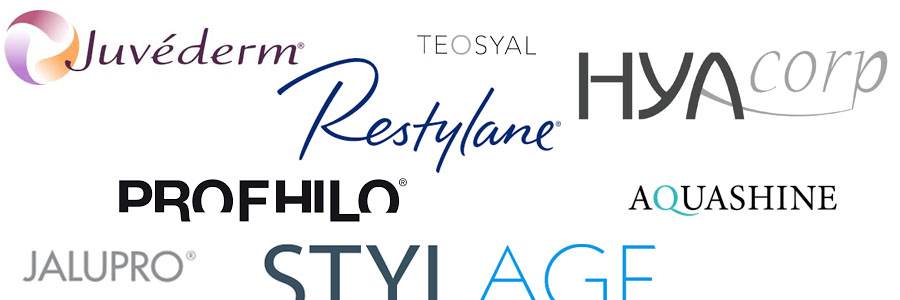
No one can avoid the inevitable aging process. Aging is a natural part of life, and how we live our lives affects how our skin ages. Luckily, modern technology has given us dermal fillers: a non-surgical procedure to restore the youthful appearance to an aging face.
Continue reading and understand how dermal fillers can be a helpful way for you to restore your youthful appearance!
WHAT ARE DERMAL FILLERS?
Dermal fillers are injectable gels used to fill out lines and wrinkles, create volume, and to restore the hydration, viscosity, and elasticity of the skin. Hyaluronic acid dermal fillers are the most widely used biodegradable fillers in both Europe and the US. Dermal fillers are often confused with or put in the same box as botox, however, the two are very different, as you can read here.
The aging process inevitably affects our skin. As we age, the skin’s natural level of hyaluronic acid is reduced significantly, resulting in the loss of facial volume and support. Visible signs of aging e.g. the formation of facial lines and wrinkles and more dry and delicate skin start to show, contributing to a more old appearance. In order to reduce the visible signs of aging, gel can be injected into the skin where it acts as a filler to smooth out lines and wrinkles and to restore lost volume. Tissue volume augmentation via this non-surgical procedure can help restore the youthful appearance to an aging face.
THE SCIENCE BEHIND HA DERMAL FILLERS

Hyaluronic acid is a glycosaminoglycan, a vital substance, which is naturally found in the human dermis. Hyaluronic acid is, among other things, found as cell surface molecules and is a vital component of all connectivity tissue.
Hyaluronic acid is a youth-supporting part of the skin. The magic lies in hyaluronic acid’s ability to replenish moisture. Hyaluronic acid is responsible for drawing water into the skin. Skin with a balanced hydration level appears more voluminous and the result is more young and healthy-looking skin. In addition, hyaluronic acid is responsible for binding collagen and elastin fibers into a supportive, protective matrix that gives the skin its structure. As we age, the skin’s natural level of hyaluronic acid is reduced, resulting in the loss of volume and hydration.
Hyaluronic acid’s moisture-binding characteristic is exceptionally important when it comes to the skin’s aging process. One of the qualities of young skin is its ability to bind water and retain a balanced hydration level. As we age, our skin loses the ability to maintain its vital moisture level. Therefore, by injecting hyaluronic acid fillers into the skin, we can create a volumizing effect as the injected hyaluronic acid will retain and bind water in the skin and thereby restore lost volume and moisture.
WHAT IS CROSS-LINKING HYALURONIC ACID?
Non-cross-linked hyaluronic acid breaks down in the skin faster than cross-linked hyaluronic acid. Therefore, in order to produce a viscoelastic material with an increased longevity when injected into the skin, hyaluronic acid fillers are cross-linked. Cross-linking is a process that binds the molecules together, which slows down the filler breakdown process. This means that the greater the cross-linking of the filler, the more compact it is and the longer it lasts. However, the concentration and particle size of the product also has an impact on the duration of the effect of the dermal filler.
TREATMENT AREAS USING DERMAL FILLERS
Hyaluronic acid dermal fillers can be used to fill out lines and wrinkles, create volume, and to restore the hydration level in different areas. In general, the face can be divided into three areas: the upper face, mid-face and lower face.
Upper face: In the upper face, some of the most common treatment areas are glabellar lines, the symmetrical lines between the eyebrows, and forehead lines, the horizontal lines caused by the dynamic action of the frontalis muscles.
Mid face: In the mid-face, some of the more common signs of aging are the appearance of crow’s feet, hollow eyes and nasolabial lines. Loss of volume in the cheeks is also common in this area.
Lower face: In the lower face, lines develop as the result of repetitive motion of the underlying musculature around the mouth. In this area, marionette lines and chin lines are common, but dermal fillers are also ideal to restore the volume and fullness of the lips.
In general, smaller gel particle sizes is ideal to use in areas where fine and superficial lines appear whereas larger gel particle sizes are more ideal to use in areas with deeper and more prominent lines and wrinkles.
HOW LONG DOES THE EFFECT OF DERMAL FILLERS LAST?
The majority of today’s dermal fillers are biodegradable, non-permanent fillers that will eventually break down in the body. Permanent fillers on the other hand are fillers that stay in the skin permanently. Somewhere between non-permanent and permanent fillers is a range of semi-permanent fillers that can take several years to break down in the body.
The duration of the dermal filler depends on the source and extent of cross-linking and concentration and particle size of each product. Generally, biodegradable fillers have effects lasting from 6 to 18 months. Increased cross-linking and concentration increase the viscosity and elasticity as well as the resistance to degradation in the body. In other words; the greater the cross-linking and concentration of the filler, the more compact it is and the longer it lasts. In addition, the duration depends on the treatment area and the individual's lifestyle, age, and skin type.
POPULAR DERMAL FILLER BRANDS

The list of dermal filler brands is long – very long. Two of the most popular brands of hyaluronic acid dermal fillers are Juvéderm and Restylane. Juvéderm is Allergan’s collection of hyaluronic acid fillers formulated to add volume to different areas of the face. All the fillers in the Juvéderm collection are smooth, crystal-clear HA gels. Restylane offers a broad portfolio of hyaluronic acid fillers for creating natural-looking results. The Restylane product line is specifically designed to restore facial volume as well as enhancing facial shape and contour. Find more information about Juvéderm here and Restylane here.
RISKS ASSOCIATED WITH DERMAL FILLERS
Dermal fillers are essentially foreign elements that are injected into the skin. As with any procedure that breaks the surface of the skin, injections with dermal fillers are associated with the risk of side effects but also more serious complications. When a dermal filler is injected into the skin, the movement of the needle through the skin’s layers may cause an inflammatory process.
The most common side effects encountered after treatment with dermal fillers are temporary pain, induration, bruising, tenderness, itching, edema, and erythema at the injection site. These reactions are normal after injection and they usually resolve a few days after the treatment. In a few cases, patients may experience more long-duration complications after injection. Fortunately, these complications are more rare.
In order to minimize the risk of complications, it is important that the treatment area is disinfected and the filler product is injected into the skin with a fine, sterile needle. Also, it is important that the nurse or doctor knows the patient's medical history and that the patient is informed in detail about the effect and the duration of the treatment and any precautions before, during and after the treatment.
By Camilla Mikkelsen | October, 2019
Please share with: ![]() Linkedin.com
Linkedin.com ![]() Reddit.com
Reddit.com

